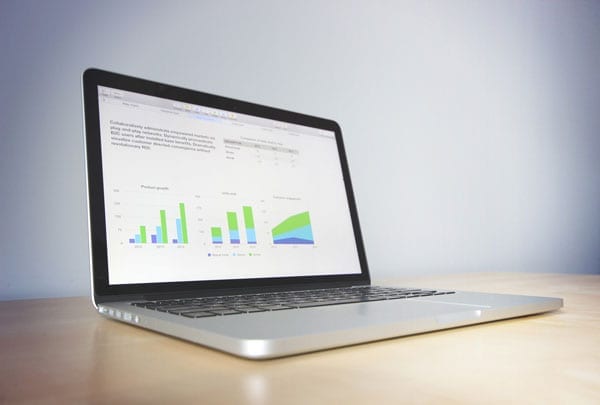Key performance indicators (KPIs) are vital for a firm’s ability to judge how well it is performing. Once you have identified some of your most important metrics, you can use them to provide a standardized way of determining whether or not you are meeting their goals, targets and objectives.
KPIs are almost always numbers, but will differ from business to business and can be used to measure virtually anything. In this blog post we’ll look at the common indicators of a healthy business. Keeping an eye on the KPIs will help you identify and mitigate any challenges before they become crises.
Which KPIs Should I Measure?

Ensure that you are regularly recording and evaluating KPIs. Set a monthly (or quarterly) reminder in your calendar as a simple trick to stay on top of it.
Different businesses will use different indicators to measure their success. What is important to one business might be irrelevant to another. So, KPIs might include not just metrics relating to revenue or sales volumes, but also reports on customer satisfaction.
Some of your KPIs will be measured regularly throughout the life of your business, while others will only be relevant for a short time. Having a seriously organized month and recording all of this data is entirely useless; the numbers only become relevant when they are measured over an extended period of time, and trends and patterns can be identified. Ensure that you are regularly recording and evaluating KPIs.
One of the biggest challenges for the small business owner is keeping score. How do you know when you’ve had a great week, month or year? What figures should cause alarm bells to start ringing?
Gross Profit Margin
It’s impossible to make any money if you are paying more for your products or services than the price at which you are able to sell them. The price at which you sell your widget should be sufficient to cover build/purchase costs, fixed overheads such as a building lease and staff, and still leave you with a profit at the end.
Here is the equation to calculate this: gross profit margin = (revenue – costs of goods sold)/revenue
If you want to take this one step further and check out the gross profit margin as a percentage of total sales, this is the equation for you: (gross profit margin/revenue x 100)/revenue
If this figure goes up over time, it’s an indication that your fixed product costs are dropping; conversely, if this figure goes down it could be an indication that you are paying too much for your supplies.
Net Profit
Often referred to as the bottom line, this is the real deal. Net profit is the amount of money you have left after paying absolutely everything.
This is how to work out your net profit: net profit = total revenue – total expenses
If you are a sole proprietor, your salary will come out of the net profit; it’s important that you make sure you have enough in the pot at this stage to cover all of your costs and provide your family the lifestyle you desire.
Lifetime Customer Value
Lifetime customer value is a prediction of the amount of money each customer will spend with you during the lifetime of your relationship. At the beginning this may be an educated guess; however, if you use a CRM (customer relationship management) application, the amount can be tracked over time.
Knowing your lifetime customer value is empowering, as it allows you to determine how much a customer is worth to you and therefore how much you can spend acquiring new customers.
For example, let’s say each customer generally spends $1,000 with you in every transaction and over the lifetime of the relationship, they spend $25,000. The lifetime customer value is $25,000. If your gross profit margin is 50% ($12,500 in this example), you can afford to spend 20% acquiring that customer and still make a profit.
However if it costs you as much or, even worse, it costs you more to acquire a new customer than the customer is worth to you, then you will never make money in your business. You will need to evaluate your business model at that point.
Attrition
Every business loses customers. The rate at which you lose those customers is known as attrition, or churn rate. Measuring your churn rate over 90 days is an effective measure, as it gives a solid idea of the number of customers that drop your product and don’t return to it. Measuring over 30 days is another option; however, it may not identify those that temporarily drop your product and then return a short time later.
Key Performance Indicators Are Crucial
These are just a selection of the key performance indicators you can use to monitor the health of your small business. If you don’t feel your strengths lie in managing the figures, bring someone into your business to do it for you; even if it’s just for a few hours per month to create the headline numbers for you, it might pay off in the end.
About Scale Funding
Scale Funding is an invoice factoring company serving businesses across the United States. For more information on factoring, call (800) 707-4845 for a free, no-obligation consultation and quote.
RESOURCE CENTER
Learn More About Business
What’s Affecting U.S. Manufacturing (Positive & Negative)
Why Your Manufacturing Business Needs Accounts Receivable Financing Discover what’s driving U.S. manufacturing challenges and growth, and why accounts receivable…
MERCHANT CASH ADVANCES – BEWARE!
Q: What should businesses know before taking a Merchant Cash Advance (MCA)? A: Merchant Cash Advances (MCAs) may offer fast…
Tariffs, Duties, and Regulatory Volatility in Logistics
Tariffs. Duties. Regulatory up‑and‑downs. For anyone in the world of logistics, it’s like juggling flaming torches, exciting but nerve‑wracking. In…


